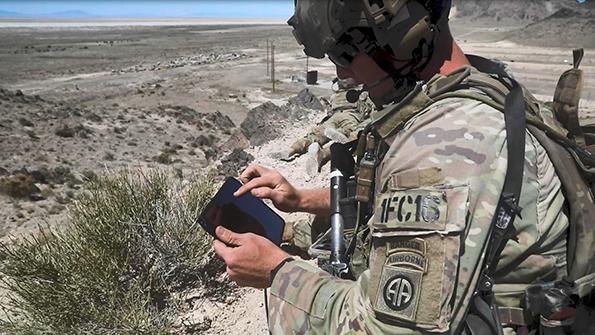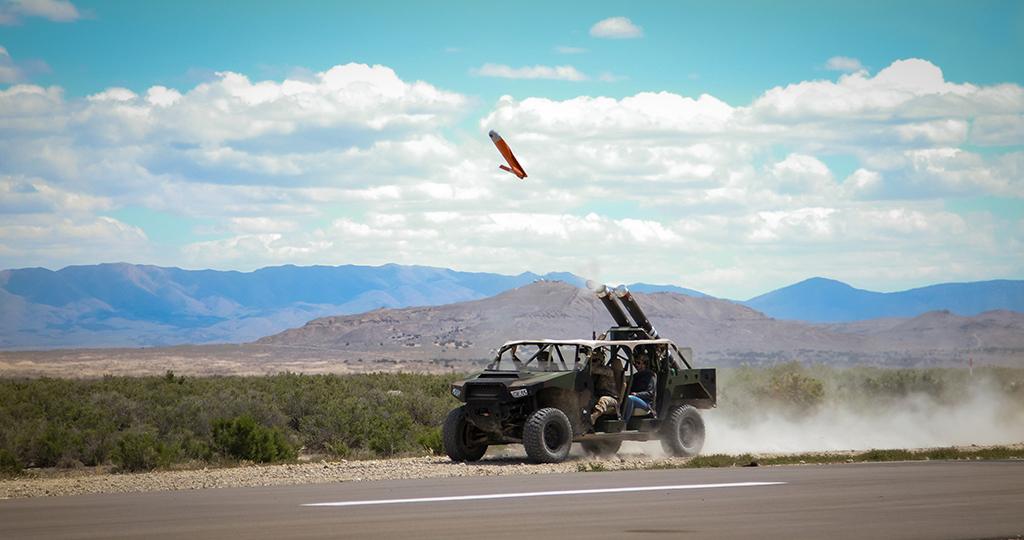
First Lt. Frankie Whalen hopped off a Future Long-Range Assault Aircraft at Objective Adams with an M4 carbine and a tablet computer strapped to his body.
A newly declassified loitering munition had just punched a hole in the enemy’s air defenses, allowing Whalen’s Future Long-Range Assault Aircraft (FLRAA)-delivered squad to lead the 82nd Airborne Division’s invasion of Cedar Island, the site of a critical airfield for a planned island-hopping campaign in Southeast Asia.
- Two new aerial vehicles revealed
- Soldiers take control of Air-Launched Effect
After his squad secured the landing zone, Whalen swung the M4 to his side and used both hands to grab his steno notepad-size tablet. Although he had been introduced to the technology less than two weeks ago, it took only a few finger taps for Whalen to accomplish his task: taking control of an Air-Launched Effects (ALE)-Small—a 27-lb. Altius 600—jettisoned by the departing FLRAA. Within seconds, Whalen was flying an unmanned aircraft system (UAS) over his squad’s blind spots at Objective Adams, swinging the onboard sensor around to search for an enemy ambush.
Not that Whalen is fully satisfied with the new digital tool. “It could be more user-friendly,” Whalen said afterward.
In reality, Objective Adams was not a contested island somewhere in the Indo-Pacific region but the base of a dusty slope on the 800,000-acre testing range at Dugway Proving Ground, Utah.
On the eve of the U.S. entry into World War II, Gen. George Patton experimented with new approaches to counter German blitzkrieg tactics during the so-called Louisiana Maneuvers, using 400,000 soldiers to simulate combined arms warfare in the woody swamps around Shreveport.
Eighty-years later, the Army is again experimenting with tactics for a new style of warfare, bringing 50 brand-new technologies—including many that are still classified—to the Utah desert in early May for the Experimental Demonstration Gateway Exercise (EDGE) 21.

“This will be known as the ‘Utah Maneuvers,’” says Army Chief of Staff Gen. James McConville, who spoke to reporters at the end of a one-day showcase of EDGE experiments for VIPs, including representatives from the Office of the Defense Secretary and congressional staffers.
The Army is not preparing to fight blitzkrieg-style warfare today but something more troublesome. If a conflict erupts with China, for instance, the Army hopes to strike thousands of targets within days or even hours.
For generals, such as McConville, the challenge is adapting to the necessary speed of controlling such a volume of strikes across the vast and varied Indo-Pacific theater. For lieutenants, such as Whalen, the challenge is mastering the ability to summon the full might of U.S. military resources to his advantage, whether relaying a hypersonic missile strike via satellite or operating an ALE-Small without fear of accidentally crashing it into a nearby FLRAA.
By now, the Army has become expert at deconflicting airspace crowded with UAS and manned aircraft, and Whalen was not concerned. The ALE-Small he controlled had been programmed with operating parameters to avoid collisions with manned aircraft vertically and horizontally, he said.

The Army also showed other new tools that Whalen’s squad could summon during the EDGE 21 demonstration. A new ALE-Large, identified as the L3Harris Red Wolf, adds a 6-ft.-long, turbojet-powered UAS to the General Atomics MQ-1C’s options of air-launched tools. In this case, the Red Wolf—developed secretly by the Defense Department’s Strategic Capabilities Office with a German-made turbojet—functioned as an airborne communications relay.
More intriguingly, the Army partially declassified a new loitering munition program. Identified only as the Long-Range Effect (LRE), three of the winged munitions targeted the components of a Russian Pantsir-like, short-range air defense system on the Dugway range. A timing issue prevented one LRE from launching at the Pantsir itself, but the other two destroyed the launcher’s command-and-control bunker and radar site.
In the skies, the Army flexed new airborne sensing capabilities. The short-range air defenses guarding Objective Adams were identified by the Artemis (Airborne Reconnaissance Target Exploitation Multi-Role Intelligence System) aircraft, a Bombardier Challenger 600 modified with synthetic aperture radar, electro-optical and infrared sensors and electronic warfare receivers. The Artemis identification data was refined by Altius 600s launched by an MQ-1C, yielding coordinates for the LREs to strike.
The unclassified experiments offered only a taste of the technologies showcased during EDGE 21. Army officials acknowledged, for example, that the targeted threats during the event included a classified long-range air defense system but provided no details. Two U.S. Marine Corps Lockheed Martin F-35Bs, which joined the Army-led event, were assigned to attack those threats, but all the details of how the targets were identified, located and attacked were kept secret.






Comments